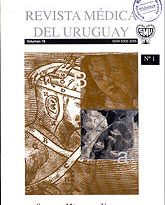Diagnosis of ciliary dyskinesia by electronic microscopy
Abstract
Primary ciliary dyskinesia is an inherited disease characterized by microanatomic or functional disorders affect to cilia or flagellum of the spermatozoa. Clinical signs include early recurrent infections of the aerial routes. Despite genetic determinants, recurrent infection and inflammation -as well as environmental agents- may lead to unspecific ciliar alterations and secondary ciliary dyskinesia.
Forty nasal and bronchial biopsies of 33 people suspected to carry ciliar dyskinesia were referred to the Cellular Biology Laboratory (Instituto de Investigaciones Biológicas Clemente Estable) and analyzed by electronic microscopy by transmission.
The overall study showed that 9 patients (27%) had abnormal ciliary ultrastructure compatible with primary ciliary dyskinesia diagnosis, of which three had situs inversus totalis. Secondary ciliary dyskinesia was seen in 52% of the patients and 21% of the patients showed, despite clinical signs, a normal ciliary ultrastructure. On average, results of the study tend to confirm high incidence of ciliar disorders in patients with chronic respiratory disorders. Considering that early diagnosis is essential in order to prevent permanent respiratory disorders, cilial ultrastructural examination should be considered in patients with situs inversus and sibling, as well as in patients with chronic and severe respiratory disease without ethyologic diagnosis.
References
2) Afzelius BA. Immotile cilia syndrome:past, present and prospect future. Thorax 1998; 53:894-7.
3) Pedersen M, Rebbe H. Absence of arms in the axoneme of immobile human spermatozoa. Biol Reprod 1975; 12:541-4.
4) Afzelius BA, Eliasson R, Johnsen O, Lindhomer C. Lack of dynein arms in immotile human spermatozoa. J Cell Biol 1975; 225-32.
5) Camner P, Mossberg B, Afzelius BA. Measurement of tracheobronquial clearance in patients with immotile cilia syndrome and its value in differential diagnosis. Eur J Resp Dis 1983; 64:57-63.
6) Pedersen H, Mygind N. Absence of axonemal arms in nasal mucosa cilia in Kartagener's syndrome. Nature 1976; 262:494-5.
7) Afzelius BA. A man syndrome caused by immotile cilia. Science 1976; 193:317-9.
8) Eliasson R, Mossberg B, Camner P, Afzelius BA. The immotile cilia syndrome. A congenital ciliary abnormality as an etiologic factor in chronic airways infections and man sterility. N Engl J Med 1977; 297:1-32.
9) Rossman Cm, Forrest JB, Lee RMKW, Newhouse MT. The dyskinetic cilia syndrome. Ciliary motility in immotile ciliary syndrome. Chest 1980; 78:580-9.
10) Veerman AJP, Van der Baan A, Waltevreden EF, Leene W, Feenstra L. Cilia:immotile, dyskinetic, dysfunctional. Lancet 1980; 2(8188):266-7.
11) Rott HD. Genetics of Kartagener's syndrome. Eur J Resp Dis 1983; 64 (suppl.127):1-4.
12) Perraudeau M. Grand Rounds Hammersmith Hospital. Late presentation of Kartagener's syndrome. Br Med J 1994; 308:519-21.
13) Holzman D, Ott PM, Félix H. Diagnostic approach to primary ciliary dyskinesia:a review. Eur J Pediatr 2000:159:95-8.
14) Bush A. Primary ciliary dyskinesia. Acta Otorhinolaryngol Belg 2000; 54:317-24.
15) Teknos TN, Metson R, Chasse T, Malercia G, Dickersin GR. New developments in the diagnosis of Kartagener's syndrome. Otolaryngol Head Neck Surg 1997; 116:68-74.
16) Bertransd B, Collet S, Eloy P, Rombaux P. Secondary ciliary dyskinesia in upper respiratory tract. Acta Otorhinolaryngol Belg 2000; 54:309-16.
17) Mygind N, Pedersen M, Nielsen MH. Primary and secondary ciliary dyskinesia. Acta Otolaryngol 1983; 95:688-94.
18) Rossman CM. Primary ciliary diskinesia:evaluation and management. Pediatr Pulmonol 1988; 5:36-50.
19) Meeks M, Bush A. Primary ciliary dyskinesia. Pediatr Pulmonol 2000; 29:307-16.
20) Date H, Yamashita M, Nagahiro I, Aoe M, Andou A, Shimizu N. Living-donor lobar lung transplantation for primary ciliary dyskinesia. Ann Thorac Surg 2001; 71:2008-9.
21) Armengot M, Escribano A, Carda C, Sánchez C, Romero C, Basterra J. Nasal mucociliary transport and ciliary ultrastructure in cystic fibrosis. A comparative study with healthy volunteers. Int J Pediatr Otorhinolaryngol 1997; 40:27-34.
22) Barlocco EG, Valleta EA, Canciani M, Lungarella G, Gardi C, De Santi MM, et al. Ultrastructural ciliary defects in children with recurrent infections of the lower respiratory tract. Pediatr Pulmonol 1991; 10:11-7.
23) Meeks M, Bush A. Primary ciliary dyskinesia. Curr Pediatr 1998; 8:231-6.
24) Gulisano M, Pacini S, Ruggiero M, Pacini A, Delrio AM, Pacini P. In vitro effects of some differentiation inductors in metaplasic epithelium of human nasal cavity. Cell Tissue Res 1996; 285:119-25.
25) Jorissen M, Willems T, Van der Schueren B. Ciliary function analysis for diagnosis of primary ciliary dyskinesia:advantages of ciliogenesis in culture. Acta Otolaryngol 2000; 120:291-5.
26) Jorissen M, Willems T, Van der Schueren B, Verbeken E. Secondary ciliary dyskinesia is absent after ciliogenesis in culture. Acta Otorhinolaryngol Belg 2000; 54:333-42.
27) Jorissen M, Willems T, De Boeck K. Diagnostic evaluation of mucociliary transport:from symptoms to coordinated ciliary activity after ciliogenesis in culture. Am J Rhinol 2000; 14:345-52.
28) Passali D, Bellussi L, Bianchini-Ciampoli M, De Seta E. Experiences in the dteremination of nasal mucociliary transport time. Acta Otolaryngol 1984; 97:319-23.
29) Canciani M, Barlocco EG, Masetlla G, de Santi MM, gardi C, Lungarella G. The saccharin test meted for testing mucociliary function in patients suspected of having primary ciliary disquinesia. Pediatr Pulmonol 1988; 5:210-4.
30) Karadag B, James AJ, Gültekin E, Wison NM, Bush A. Nasal and lower airway level of nitric oxide in children with primary ciliary dyskinesia. Eur Respir J 1999; 13:1402-5.
31) Lefevre L, Willems T, Lidberg S, Jorissen M. Nasal nitric oxide. Acta Otorhinolaryngol Belg 2000; 54:271-80.

This work is licensed under a Creative Commons Attribution-NonCommercial 4.0 International License.













